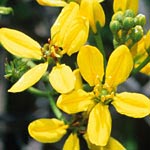

1. Specimens with flowers.
2. Anthers dehiscing by apical or subapical pores; petals yellow, sometimes with a red claw; corolla bilaterally symmetrical (2 petals up, 2 lateral, 1 down).
3. Petals coarsely dentate; styles 2, alike; leaves mostly alternate, opposite or subopposite in some species; pedicels sessile (i.e., without a peduncle between bract and joint at base of pedicel).
3. Petals entire or denticulate; style usually 1 (sometimes a second, usually shorter, style developed); leaves mostly opposite, sometimes subopposite or in verticils of 3 or 4; pedicels pedunculate (i.e., peduncle developed between bract and joint at base of pedicel).
2. Anthers dehiscing longitudinally; petals pink, white, or pale yellow (?); corolla radially or bilaterally symmetrical.
4. Petals entire or the margin merely undulate; corolla radially symmetrical.
5. Petals exposed in enlarging buds.
6. Petals narrowly spatulate, without a clear distinction between limb and claw.
7. Styles 2; stigmas small, terminal; leaves borne in fascicles, the fascicles alternate.
7. Styles 3; stigmas large, lateral, inflexed; leaves opposite, in pairs.
8. Fruit unwinged or bearing only 3 small rudimentary winglets, incapable of effecting wind distribution.
8. Fruit bearing well-developed wings or winglets, obviously functional in distribution by wind.
9. Fruit bearing several elongated narrow winglets, most of them lateral.
9. Fruit bearing 1 dorsal wing on each carpel or 1 ± circular or elliptical lateral wing on each carpel, often with a small dorsal crest as well.
10. Fruit bearing 1 ± circular or elliptical lateral wing on each carpel, often with a small dorsal crest as well, mostly breaking apart into as many samaras as there are carpels (indehiscent in Caucanthus auriculatus).
11. Fruit indehiscent, bearing 3 lateral wings with bladders in their bases.
11. Fruit breaking apart into as many samaras as there are carpels (2 or 3).
10. Fruit bearing 1 elongated dorsal wing on each carpel, breaking apart into (2) 3 samaras, each with 1 dorsal wing and no lateral winglets.
6. Petals with a broad limb clearly differentiated from the claw.
5. Petals nearly or completely concealed by sepals in enlarging buds.
4. Petals all or some distinctly fimbriate; corolla ± bilaterally symmetrical.
Caucanthus albidus
Triaspis
1. Specimens with fruits.
12. Leaves on vegetative stems borne in alternate fascicles; samaras 2 in each fruit.
Caucanthus albidus
12. Leaves opposite, in pairs; samaras 3 in each fruit.
13. Leaf glands on petiole and margin of lamina, not in abaxial surface; pedicels sessile (i.e., without a peduncle between bract and joint at base of pedicel); wing of samara cleft to nut at apex; stigma terminal.
13. Leaf glands none on petiole (always?), present in abaxial surface of lamina, not on margin; pedicels pedunculate (i.e., peduncle developed between bract and joint at base of pedicel); wing of samara mostly entire or only shallowly notched at apex, but sometimes broadly notched; stigma lateral, inflexed.
Triaspis